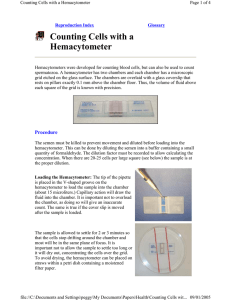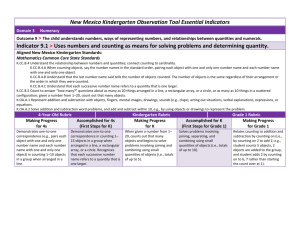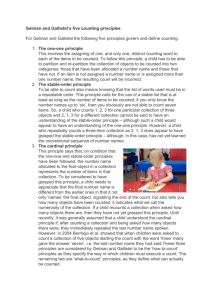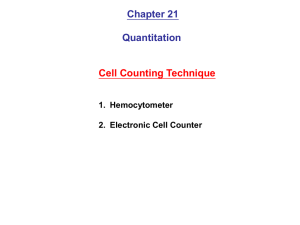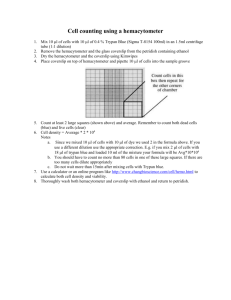Counting cells
advertisement
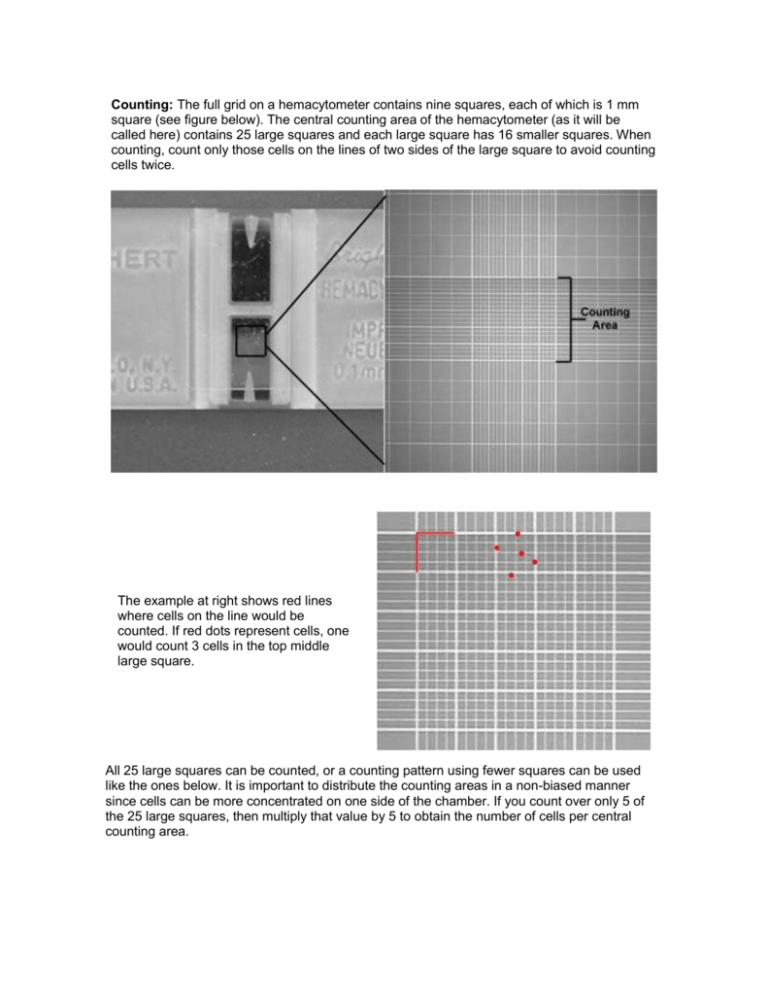
Counting: The full grid on a hemacytometer contains nine squares, each of which is 1 mm square (see figure below). The central counting area of the hemacytometer (as it will be called here) contains 25 large squares and each large square has 16 smaller squares. When counting, count only those cells on the lines of two sides of the large square to avoid counting cells twice. The example at right shows red lines where cells on the line would be counted. If red dots represent cells, one would count 3 cells in the top middle large square. All 25 large squares can be counted, or a counting pattern using fewer squares can be used like the ones below. It is important to distribute the counting areas in a non-biased manner since cells can be more concentrated on one side of the chamber. If you count over only 5 of the 25 large squares, then multiply that value by 5 to obtain the number of cells per central counting area. At least two chambers should be counted, including at least 100 cells within each central counting area of each chamber. For higher precision, additional cells can be counted and the average used to calculate cell concentration. Calculating Concentration Each of the nine squares on the grid, including the central counting area of 25 large squares, has an area of 1 square mm, and the coverglass rests 0.1 mm above the floor of the chamber. Thus, the volume over the central counting area is 0.1 mm3 or 0.1 microliter. You can thus multiply the average number of cells over each central counting area by 10,000 to obtain the number of cells per ml of diluted sample. In other words, to calculate the number of cells per ml of original sample: 1. Calculate the mean number of cells counted for each chamber (i.e. for each of the central counting areas of each chamber). 2. Multiply the mean obtained in (1) by 10,000 to obtain the number of cells per ml of diluted sample. 3. Multiply the count obtained in (2) by the dilution factor. Example: Assume that you dilute the original cells sample by adding 0.1 ml of cells to 9.9 ml of diluent (1:100 dilution factor). You then count the number of cells in 5 of the 25 large squares within the central counting area of two chambers, obtaining counts of 132 and 128 cells. 1. The mean number of cells per chamber is thus 130 x 5 or 650 cells per counting area (650 cells per 0.1 microliter). 2. Multiply the 650 cells per counting area by 10,000 to obtain the number of cells per ml of diluted sample (answer = 6,500,000) 3. Multiply 6,500,000 cells per ml of diluted sample by 100 (the dilution factor) to obtain 650,000,000 per ml of original cells sample. QUANTIFYING CELLS WITH A HEMACYTOMETER 1. 2. 3. 4. Make 500 ul of a 5% dilution cells (yeast) with distilled water. Place one drop on the hemacytometer. Allow to settle for ~1 minute. Determine the countability of this preparation. Dilute to the necessary concentration and determine Data: What is the concentration of yeast in the stock solution? What is the concentration of yeast in your solution of 5%. How many total number of yeast cells are present in your 5% test tube? How many total number of yeast are present in the stock solution?


